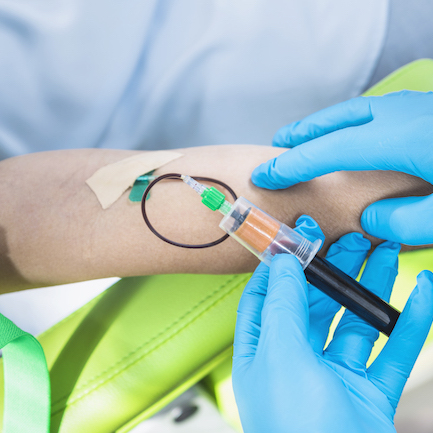Don't leave everything to chance; keep yourself protected with an insurance

L-PRF stands for Leukocyte- and Platelet-Rich Fibrin. Leukocytes and platelets are both different kinds of blood cells that work within different systems in your body to promote healing.
L-PRF is a kind of bioactive bandage created from your own blood. This method releases your body’s own natural healing proteins, resulting in a more efficient healing process.
First, we’ll take a sample of your blood, similar to how we might for a blood test. Then, Dr Blevins will use something called an IntraSpin™ System to spin your blood in a centrifuge, separating and concentrating cells and active proteins important for healing. Once it has been prepared, we can place the L-PRF in your surgery sites.
Once L-PRF has been placed, it can get to work enhancing your body’s natural healing process. Since L-PRF is made of your own blood cells, reintroducing them into your own surgical site allows your body to create a sort of scaffolding for healing out of powerful proteins.
In some cases, we may need to supplement your L-PRF clot with additional materials. For example, if you’re dealing with significant bone loss, we may add bone growth material to promote your own bone regeneration during the healing process.
Helps to restore peri-implant bone
When you lose your natural teeth, you can replace them with implants.
If you have less bone around your implants, PRF helps in depositing healthy new bone around them. By attracting osteoblasts (bone-forming cells) to the area of concern as well as with the help of stem cells, PRF helps in bone regeneration.
Preserves alveolar ridge
The alveolar bone is the jaw bone that supports your teeth. After removing your teeth, whatever bone remains is known as the alveolar ridge. Sufficient jaw bone makes it good for implants or helps you retain your dentures (artificial teeth set.)
Heals periodontal defects
Teeth get weak or loose when there is bone resorption (destruction) around them. PRF generates new bone and thus, improves the health of your teeth. PRF can reduce the probing depths too.
PRF is useful in oral cancer
After cancer surgery, PRF can reconstruct the bony defects.
Helps in gum regeneration
PRF also helps to enhance the gum volume.
Heals mucosal margins which sutures can’t heal
Doctors suture when necessary, for instance after surgeries to facilitate healing. PRF helps in joining mucosa (soft tissue) which even sutures fail to heal.
Prevents and treats infections
Thanks to leucocytes. In addition, PRF has antibacterial properties.
Speeds up wound healing
Maxillary sinus augmentation
Some studies say PRF is probably the only material that can augment maxillary sinus floors.
A maxillary sinus augmentation is also known as the sinus lift procedure. Sometimes there can be a perforation in the maxillary sinus during the sinus lift procedure and go unnoticed. PRF heals such perforations by depositing bone.
PRF reduces osteitis
PRF reduces osteitis (inflammation of the bone) by up to 90%.
PRF is a natural surgical additive, which carries low risks and provides good results. PRF is suitable to be used alone as well as in combination with other biomaterials.
Our dentists continually attend further education and stay on top of current research to bring the best evidence based treatments and the latest techniques.
We use the latest treatment techniques, procedures & dental materials that enable us to deliver a wide range of options to suit your needs.
Also, we use a wide variety of cosmetic dentistry options and treatments to transform your regular smile into a million-dollar one. We offer all your treatments in the same place, whichever specialist you may need to see, you will find them available here.

© 2021 Right Choice Insurance Designed by Amplispot
Privacy Policy | Terms & Conditions